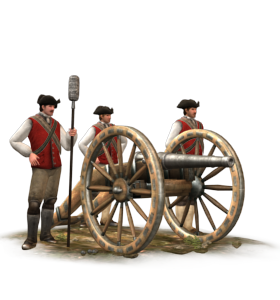Difference between revisions of "Sakers (ETW Unit)"
Tango12345 (talk | contribs) |
Tango12345 (talk | contribs) (→Tactics) |
||
| Line 12: | Line 12: | ||
Although obsolescent, there were 14 sakers in the “Blenheim train” of artillery in 1704 available to the Duke of Marlborough – guns were expensive and he took what was available. | Although obsolescent, there were 14 sakers in the “Blenheim train” of artillery in 1704 available to the Duke of Marlborough – guns were expensive and he took what was available. | ||
| − | == | + | ==Details== |
Sakers are some of the earliest cannons most factions can field. They are immobile and lack firepower. However, they may have practical applications early on if canister shot is researched speedily. They lose their prevalence as better artillery such as horse and foot artillery become available. | Sakers are some of the earliest cannons most factions can field. They are immobile and lack firepower. However, they may have practical applications early on if canister shot is researched speedily. They lose their prevalence as better artillery such as horse and foot artillery become available. | ||
Revision as of 12:26, 10 October 2011
 A saker is an old-fashioned style of light cannon, deployed in a fixed position.
A saker is an old-fashioned style of light cannon, deployed in a fixed position.
Overview
Artillery pieces are expensive to cast; as a result, they tend to be in service until captured, destroyed or rusted away. Sakers are a prime example of this, as many of the barrels date back to the 17th Century, even if they have been taken from dust-covered warehouses and mounted on refurbished carriages.
They are relatively light cannons in terms of the shot fired, which is much the same as a six-pounder. Some sakers are even old enough to have been intended for stone ammunition, and this is reflected in the fact that the windage (or difference between the barrel bore and shot size) is often quite large. This “rattling” of a shot down the barrel when it is fired does not help accuracy.
Despite the light weight of shot, sakers are anything but lightweight guns. Saker gun carriages are large, awkward and tactically immobile. Gunners and draft animals can drag them into place before a battle, but there is little chance of moving a gun to a better firing position once the action has commenced.
Although obsolescent, there were 14 sakers in the “Blenheim train” of artillery in 1704 available to the Duke of Marlborough – guns were expensive and he took what was available.
Details
Sakers are some of the earliest cannons most factions can field. They are immobile and lack firepower. However, they may have practical applications early on if canister shot is researched speedily. They lose their prevalence as better artillery such as horse and foot artillery become available.
If they remain immobile for more than two turns on the world map, sakers (as well as other fixed artillery) gain the option to deploy sandbags around them as a small measure of protection.
Factions
 Great Britain
Great Britain United Provinces
United Provinces Austria
Austria Bavaria
Bavaria Dagestan
Dagestan Gran Colombia
Gran Colombia Courland
Courland Denmark
Denmark France
France Genoa
Genoa Georgia
Georgia Greece
Greece Hannover
Hannover Hessen
Hessen Hungary
Hungary Ireland
Ireland Knights of St. John
Knights of St. John Louisiana
Louisiana Mexico
Mexico Naples & Sicily
Naples & Sicily New Spain
New Spain Norway
Norway Italian States
Italian States Savoy
Savoy Poland-Lithuania
Poland-Lithuania Portugal
Portugal Prussia
Prussia Quebec
Quebec Russia
Russia Saxony
Saxony Scotland
Scotland Spain
Spain Sweden
Sweden Thirteen Colonies
Thirteen Colonies United States
United States Venice
Venice Westphalia
Westphalia Württemberg
Württemberg
